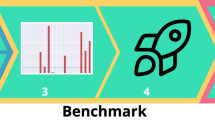Abstract
The “Binding Problem” is an important problem across many disciplines, including psychology, neuroscience, computational modeling, and even philosophy. In this work, we proposed a novel computational model, Bayesian Linking Field Model, for feature binding in visual perception, by combining the idea of noisy neuron model, Bayesian method, Linking Field Network and competitive mechanism. Simulation Experiments demonstrated that our model perfectly fulfilled the task of feature binding in visual perception and provided us some enlightening idea for future research.
Similar content being viewed by others
References
Damasio A R, Eslinger P, Damasio H, et al. Multimodal amnesic syndrome following bilateral temporal and basal forebrain damage. Arch Neurol, 1985, 42: 252–259 3977656, 1:STN:280:BiqC2cfmtlc%3D
Livingstone M, Hubel D. Segregation of form, color, movement and depth: anatomy, physiology, and perception. Science, 1988, 240: 740–749 3283936, 10.1126/science.3283936, 1:STN:280:BieB3cvptFQ%3D
Posner M I. Orienting of attention. Q J Exp Psychol, 1980, 32: 3–25 7367577, 10.1080/00335558008248231, 1:STN:280:Bi%2BC28jnvVA%3D
Crick F. Functions of the thalamic reticular complex: the searchlight hypothesis. Proc Natl Acad Sci USA, 1984, 81: 4586–4590 6589612, 10.1073/pnas.81.14.4586, 1:STN:280:BiuB2s3mvVQ%3D
Sejnowski T J. Open questions about computation in cerebral cortex. In: McClelland J L, Rumelhart D E, eds. Parallel Distributed Processing. Cambridge: MIT Press, 1986, 372–389
Treisman A, Gelede G. A feature-integration theory of attention. Cognit Psychol, 1980, 12: 97–136 7351125, 10.1016/0010-0285(80)90005-5, 1:STN:280:Bi%2BD1M%2Fnslc%3D
Albright T D, Kandel E R, Posner M I. Cognitive neuroscience. Curr Opin Neurobiol, 2000, 10(5): 612–624 11084324, 10.1016/S0959-4388(00)00132-X, 1:CAS:528:DC%2BD3cXosVGksrc%3D
Damasio A R. The brain binds entities and events by multiregional activation from convergence zones. Neur Comput, 1989, 1: 123–132 10.1162/neco.1989.1.1.123
Von der Malsburg C. Am I thinking assemblies? In: Pelm G, Aertsen A, eds. Brain Theory. Berlin: Springer-Verlag, 1986. 161–176
Gray C M, König P, Engel A K, et al. Oscillatory responses in cat visual cortex exhibit inter-columnar synchronization which reflects global stimulus properties. Nature, 338: 334–337
Guo A K. Emerging dynamic neuron assembly — new concept of brain temporal-spatial coding. Acta Biophys Sin, 1997, 13: 695–702
Horn D, Sagi D, Usher M. Segmentation, binding and illusory conjunctions. Neur Comput, 1991, 3: 510–525 10.1162/neco.1991.3.4.510
Schillen T B, Koènig P. Binding by temporal structure in multiple feature domains of an oscillatory neuronal network. Biol Cybernet, 1994, 70: 397–405 10.1007/BF00203232, 1:STN:280:ByuB2c3otl0%3D
Engel A K, Koènig P, Kreiter A K, et al. Temporal coding in the visual cortex: New vistas on integration in the nervous system. Trends Neurosci, 1992, 15: 218–226 1378666, 10.1016/0166-2236(92)90039-B, 1:STN:280:By2A3snjvVA%3D
Eckhorn R, Reitboeck H J, Arndt M, et al. Feature linking via synchronization among distributed assemblies: Simulation of results from cat cortex. Neur Comput, 1990, 2: 293–307 10.1162/neco.1990.2.3.293
Johnson J L, Padgett M L. PCNN models and applications. IEEE Trans on Neural Networks, 1999, 10(3): 480–498 10.1109/72.761706, 1:STN:280:DC%2BD1c%2FpsFSnsw%3D%3D
Gerstner W, Kistler W M. Spiking Neuron Models: Single Neurons, Populations, Plasticity. London: Cambridge University Press, 2002
Perry V H, Linden R. Evidence for dendritic competition in the developing retina. Nature, 1982, 297: 683–685. 7088156, 10.1038/297683a0, 1:STN:280:Bi2B38%2FgsVQ%3D
Poldrack R A, Packard M G. Competition among multiple memory systems: converging evidence from animal and human brain studies. Neuropsychologia, 2003, 41(3): 241–244 10.1016/S0028-3932(02)00157-4
Author information
Authors and Affiliations
Corresponding author
Additional information
Supported by the National Natural Science Foundation of China (Grant No. 60435010), National High-Tech Program (863 Program) of China (Grant No. 2006AA01Z128), National Basic Research Priorities Program of China (Grant No. 2007CB311004)
Rights and permissions
About this article
Cite this article
Shi, Z., Shi, Z., Liu, X. et al. A computational model for feature binding. SCI CHINA SER C 51, 470–478 (2008). https://doi.org/10.1007/s11427-008-0063-3
Received:
Accepted:
Published:
Issue Date:
DOI: https://doi.org/10.1007/s11427-008-0063-3




